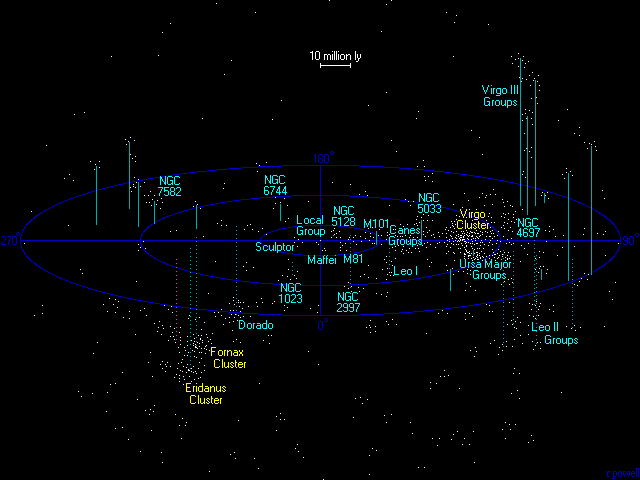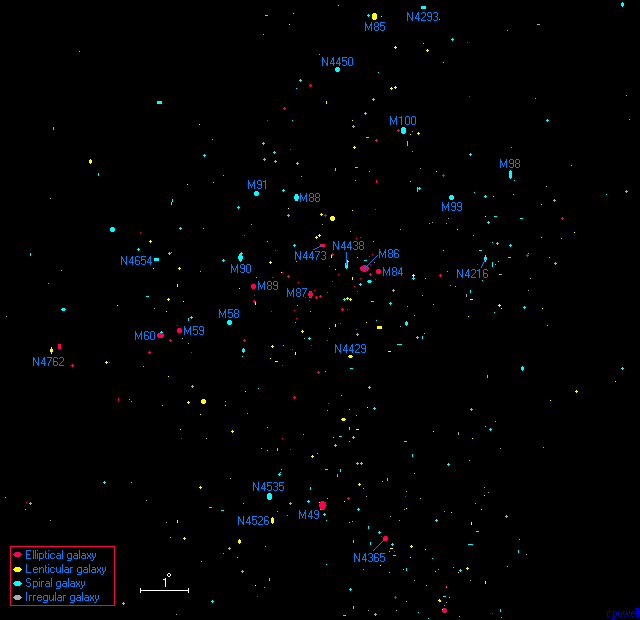| Sculptor Group |
|---|
 |
The Sculptor group is the nearest group of galaxies to the Local Group and
is dominated by five galaxies, four spiral - NGC 247, 253, 300 and 7793 and one
irregular - NGC 55. The nearest of these is NGC 55 which lies on the border of
the Sculptor group and our Local group. |
| Maffei Group |
|---|
 |
In 1968, the Italian astronomer Paolo Maffei discovered two galaxies hidden
behind the plane of our galaxy and thus heavily obscured by interstellar matter.
These two galaxies are known as Maffei 1 and Maffei 2. Together with the galaxy
IC342, and the extremely obscured galaxy Dwingeloo 1 they make up the dominant
members of another nearby group. Maffei 1 is the nearest large elliptical galaxy
to us. Although observation of the group is difficult, there are now over 20 member
galaxies known, most of which are dwarfs. |
| M81 Group |
|---|
 |
This is a prominent nearby group in Ursa Major and is centred around the famous
M81/M82 pair of galaxies together with the fairly bright NGC 2403 galaxy. M82 is
a famous starburst galaxy, the galaxy has had a close encounter with its larger
neighbour M81 in the past few million years, and the near-miss has generated a
large wave of star formation within the galaxy. |
| Canes I Group |
|---|
 |
Another nearby group centred around NGC 4214, 4244 and 4395. The spiral galaxy
M94 also probably lies at the back of this group. This group is notable for
containing a large number of medium-sized dwarf galaxies. |
| NGC 5128 Group |
|---|
 |
This is a neighbouring group of galaxies in Centaurus and is dominated by the
two spiral galaxies M83 and NGC 4945 and the large lenticular galaxy NGC 5128.
NGC 5128 is one of the brightest nearby galaxies and it is a powerful source of radio
waves (radio astronomers call the galaxy Centaurus A). The galaxy
also seems to have merged with a large spiral galaxy within the past few hundred
million years. |
| M101 Group |
|---|
 |
This group is centred around the famous M101 galaxy which is one of the nearest
giant spiral galaxies - it has a diameter of 200 thousand light years. Near this
group lies the M51 (NGC 5194) group, and these two groups are often included
together in lists as one large group. |
| Canes II Group |
|---|
 |
Another large collection of spiral galaxies in Canes Venatici, the dominant
members are probably M106, NGC 4096 and NGC 4490, but there are many other galaxy
groups in this area of the sky and this whole region is known as the Canes Cloud. |
| Leo I Group |
|---|
 |
This is a large and prominant group of spiral galaxies in Leo consisting of two
main subgroups, one centred around M65, M66 and NGC 3628, and the other centred
around M95, M96, M105 and NGC 3384. |
| Virgo Cluster |
|---|
 |
This is the most famous cluster of galaxies. It is much larger than any other
group within 100 million light years. There are about 150 large galaxies in
this cluster and at least a thousand known dwarf galaxies. This cluster
completely dominates our tiny corner of the Universe, and even our Local Group
of galaxies is being gravitationally pulled by this cluster. At the core of the
Virgo cluster lie the three large elliptical galaxies M84, M86 and M87.
These galaxies probably formed from the merger of many smaller galaxies and are
much more massive than our own galaxy. |
| Ursa Major Groups |
|---|
 |
This is a large spur of spiral galaxies on one side of the Virgo cluster
stretching across 20 million light years of space. There are probably two main
groups here - Ursa Major North (around NGC 3631, 3953, and M109) and Ursa Major
South (around NGC 3726, 3938 and 4051). |
| Virgo II Groups |
|---|
 |
The Virgo II groups are a long filament of galaxies extending southwards
from the groups of galaxies at the southern edge of the Virgo cluster. |
| Fornax Cluster |
|---|
 |
The second richest cluster within 100 million light years is the Fornax
cluster although it is much smaller than the Virgo cluster. There are actually
two neighbouring clusters here called the Fornax I cluster and the Fornax II or
Eridanus group. These two clusters contain about 50 large galaxies each. The
groups of galaxies around the Fornax cluster are sometimes called the Fornax
supercluster or Southern supercluster. |
| Leo II Groups |
|---|
 |
The Leo II Groups are a large collection of galaxy groups clustered about 30
million light years to one side of the Virgo cluster. |
| Virgo III Groups |
|---|
 |
These galaxy groups stretching away from the Virgo cluster are called the
Virgo III cloud. The gravitational pull of the Virgo cluster is probably
why this collection of groups has been stretched into a long filament. |
This is a map of the Virgo cluster - the nearest large cluster of galaxies.
The map shows the positions of 500 of the brightest galaxies in and around this
cluster. At the centre of the cluster are several massive elliptical galaxies.
It is impossible to get a good photograph of the entire cluster because the
galaxies are faint objects scattered across 15 degrees of the sky, and a large
angle photograph would be swamped by thousands of foreground stars in our own
galaxy. The 26 brightest galaxies are labeled.















